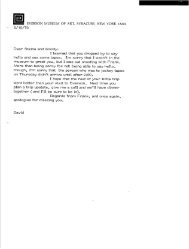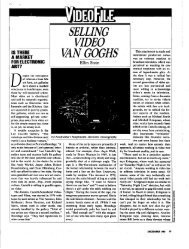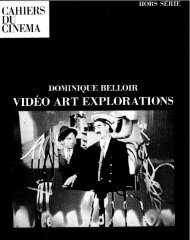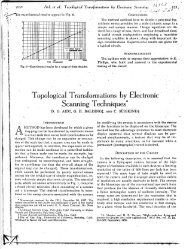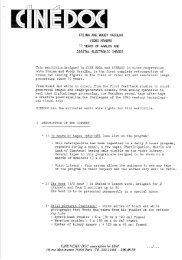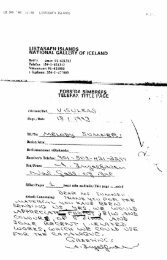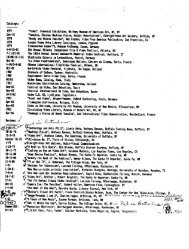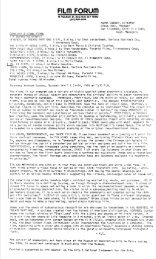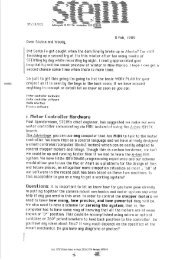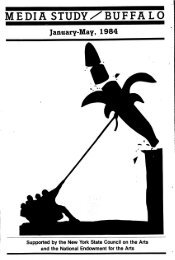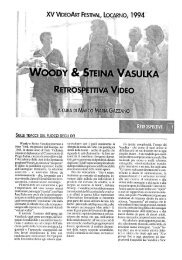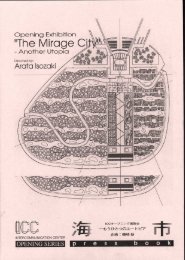Chapter 4: A HISTORY OF COMPUTER ANIMATION ... - Vasulka.org
Chapter 4: A HISTORY OF COMPUTER ANIMATION ... - Vasulka.org
Chapter 4: A HISTORY OF COMPUTER ANIMATION ... - Vasulka.org
You also want an ePaper? Increase the reach of your titles
YUMPU automatically turns print PDFs into web optimized ePapers that Google loves.
<strong>Chapter</strong> 4 : A <strong>HISTORY</strong> <strong>OF</strong> <strong>COMPUTER</strong> <strong>ANIMATION</strong> 3/20/92 20<br />
32 bit word . One of its options was the 2250, an interactive<br />
graphics display which supported a light pen . IBM was very careful<br />
to design the 360 so it could be upward compatable, that is<br />
newer versions of the machine could support additional instructions,<br />
yet the primitive instruction definitions remain constant . And<br />
indeed modules compiled on a 360 will execute on today's very<br />
latest IBM 30XX machines .<br />
Alternatives to the mainframe began to emerge in the early<br />
1960s . In 1959 Digital Equiptment Corp (DEC) introduced the PDP8,<br />
an early minicomputer . But the baseline driving the technology was<br />
the density of components in a single integrated circuit, and this<br />
continued to increase . Intel Corporation succeeded in manufacturing<br />
a single chip containing 1 kbits of memory (1970), a 4 bit ALU<br />
(1971), and finally an entire microprocessor-a single chip<br />
containing an 8 bit ALU, memory, and I/O control (1974) . Intel<br />
assumed the market for its microprocessor chip-the 8008-would<br />
consist of replacement systems for applications like smart elevator<br />
controllers . (After all, why construct mechanical switching logic<br />
when you can simulate it on a computer-furthermore a computer can<br />
be reprogrammed, to change what floors an elevator stops at, add<br />
new floors, or service calls in a different manner .) But unexpectedly<br />
a hobbyist movement exploded : boy scouts, ham radiofiles, and<br />
artists began building computer systems themselves . After all, the<br />
microprocessor was a complete computer .<br />
The breakthrough came in 1975, when Edward Robert's Micro<br />
Instruction and Telemetry Systems Company (MITS) introduced the<br />
Altair 8800 , a computer kit . In its initial version the machine had<br />
no keyboard, no alphanumeric display and was programmed by toggle<br />
switches on the front pannel, with the results displayed as status<br />
lights . Memory was 256 bytes . Within months however its S-100<br />
bus would emerge as an early standard, and software handlers for a<br />
keyboard and monitor were written, as was a loader, assembler and<br />
file system . Before the end of the year students Paul Allen and Bill<br />
Gates created a BASIC Interpreter, and a company called Digital<br />
Research created CP/M, an OS for the machine . Byte magazine was<br />
born in 1976 and in 1977 a young Steve Jobs and Michael Wozniak<br />
succeeded in designing and manufacturing an entirely stand-along<br />
personal computer system that was already assembled-the Apple .<br />
The Apple Computer included a backplane, the new 6502<br />
microprocessor, 48 kbytes of memory, a keyboard, color TV display,<br />
and casette or floppy disc peripherals . The personal computer had<br />
arrived . In 1979 Motorola introduced the 68000, a 16 bit word<br />
microprocessor, and in 1981 IBM legitimized the PC by introducing



